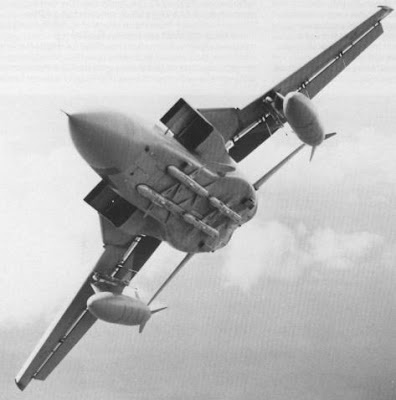The Panavia Tornado ADV was a long-range interceptor aircraft in service with the Royal Air Force between 1985 and 2012. It was designed to defend British airspace by intercepting and engaging enemy bombers flying towards the United Kingdom hundreds of miles away. For this mission, it was fitted with advanced radar and fire control avionics. It was also used as a ¨Weasel¨ (anti-radiation) aircraft, flying sorties to knock out enemy air defenses on the ground, using ALARM anti-radar missiles. 'ADV' stands for ¨Air Defense Variant¨.
The Panavia Tornado prototype P-01 first flew on August 14, 1974. The first flight tests proved satisfactory, with the aircraft also passing the weapons-handling trials as well as the speed tests. During these tests, the prototype was able to reach the speed of Mach 2. This prototype would become the multi-role combat aircraft for the British, German, and Italian Air Force. However, the Royal Air Force would be issued 229 additional Tornados, all of which would be developed into the F2 and F3 model in the Air Defense Variant (ADV) interceptor role. This version made its maiden flight on August 9, 1979.
The Panavia Tornado ADV had it baptism of fire in 1991, flying over Iraqi territory, during Operation Desert Storm. The aircraft was also deployed in numbers during the armed conflict in Bosnia as well as during the USA/UK invasion of Iraq in 2003. The Tornado ADV proved its worth as a tactical support machine, capable of engaging and destroying targets with very high accuracy. The aircraft's terrain-following radar allowed a stealthy approach to its target while flying at extremely low level at high speed.
 |
| The Panavia ADV F3 version, with its wing fully swept back as it climbs up while banking right. Notice the four Sky Flash missiles on belly of fuselage. |
Technical Description
The Panavia Tornado ADV was a two-seat, two-engine monoplane. It had an all-metal fuselage, with parts of its airframe made of titanium. It was fitted with variable-sweep wing, which was mounted on shoulder of fuselage. The wing could be moved from a full forward position of 25 degrees to a full swept-back position of 67 degrees. It had no ailerons, but full-length flaps, using spoilers for roll control. The tailplane was of conventional swept-back type, with a large vertical fin.
The nose of fuselage had a radome, which housed the Marconi's A.I-24 Foxhunter airborne interception radar, which had a range of 115 miles. The cockpit was narrow but long, with the pilot and radar operator sitting in tandem. The aircraft was powered by two Turbo-Union RB199-34R turbofan engines, each rated at 9,104 pounds of thrust. These machines were designed and built by Rolls-Royce and Aeritalia.
Specifications
Type: two-seat, long-range interceptor
Length: 18 m (59 feet, 3 inches)
Wing Span: 8.60 m (28 feet, 3 inches)
Wing Area: 26.60 m2 (286 square feet)
Height: 5.70 m (18 feet, 8 inches)
Power Plant: two 9,104-lb, Turbo-Union RB119-34R turbofan engines.
Maximum Speed: 2,338 km/h (1,453 mph)
Range: 1,800 km/ 1,118 miles (interception radius); 3,500 km full ferry range.
Service Ceiling: 21,000 m (68,900 feet)
Crew: two
Armament: one 27-mm IWKA Mauser cannon; eight BAe Sky Flash air-to-air missiles; two ALARM air-to-surface anti-radiation missiles.
 |
| The F3 version of the Tornado ADV in flight. Notice air-to-air missiles and the two external fuel tanks under wing. |
 |
| Panavia Tornado ADV F2 fully-armed, with its wing swept forwards. |
 |
| Three British ADV F3s of Squadron No5. |


